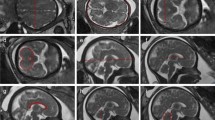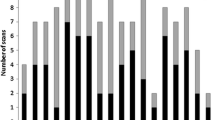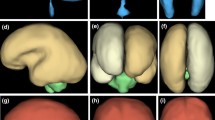Abstract
Purpose
Fetal growth assessment is a key component of prenatal care. Sex-specific fetal brain nomograms on ultrasound are available and are clinically used. In recent years, the use of fetal MRI has been increasing; however, there are no sex-specific fetal CNS nomograms on MRI. The study aimed to assess the differences in fetal brain biometry and growth trajectories and to create population-based standards of the fetal brain on MRI.
Methods
In this cross-sectional study, brain structures of singleton fetuses with normal brain MRI scans were analyzed: biparietal diameter, occipitofrontal diameter, trans-cerebellar diameter, and the corpus callosum were measured and converted into centiles. Sex-specific nomograms were created.
Results
A total of 3848 MRI scans were performed in one tertiary medical center between 2011 and 2019; of them, 598 fetuses met the inclusion criteria, 300 males and 298 females between 28- and 37-weeks’ gestation. Males had significantly larger occipitofrontal diameter than females (median 75%, IQR 54–88%; median 61%, IQR 40–77%) and biparietal diameter (median 63%, IQR 42–82%; median 50%, IQR 25–73%), respectively (p < 0.001). The cerebellum had the greatest growth rate, with a 1.5-fold increase in diameter between 28 and 37 weeks’ gestation, with no measurement difference between the sexes (p = 0.239). No significant difference was found in the corpus callosum (p = 0.074).
Conclusion
Measuring both sexes on the same nomograms may result in over-estimation of male fetuses and under-estimation of females. We provide fetal sex-specific nomograms on two-dimensional MRI.

Similar content being viewed by others
Abbreviations
- BPD:
-
Biparietal diameter
- OFD:
-
Occipitofrontal diameter
- TCD:
-
Trans-cerebellar diameter
- CC:
-
Corpus callosum
References
Tilea B, Alberti C, Adamsbaum C et al (2009) Cerebral biometry in fetal magnetic resonance imaging: new reference data. Ultrasound Obstet Gynecol 33:173–181
Chervenak FA, Jeanty P, Cantraine F et al (1984) The diagnosis of fetal microcephaly. Am J Obstet Gynecol 149:512–517
Hadlock FP, Deter RL, Harrist RB, Park SK (1982) Fetal head circumference: relation to menstrual age. Am J Roentgenol 138:649–653
Thompson LA, Moreno MA (2018) Growth and growth charts in children. JAMA Pediatr 172:604
WHO Multicentre Growth Reference Study Group (2006) WHO Child Growth Standards based on length/height, weight and age. Acta Paediatrica Supplement 450:76–85. https://doi.org/10.1111/j.1651-2227.2006.tb02378.x
Galjaard S, Ameye L, Lees CC et al (2019) Sex differences in fetal growth and immediate birth outcomes in a low-risk Caucasian population. Biol Sex Differ 10:48–48
Manganaro L, Bernardo S, Antonelli A, Vinci V, Saldari M, Catalano C (2017) Fetal MRI of the central nervous system: state-of-the-art. Eur J Radiol 93:273–283
Simon EM, Goldstein RB, Coakley FV et al (2000) Fast MR imaging of fetal CNS anomalies in utero. AJNR Am J Neuroradiol 21:1688–1698
Levine D, Barnes PD, Madsen JR, Abbott J, Mehta T, Edelman RR (1999) Central nervous system abnormalities assessed with prenatal magnetic resonance imaging. Obstet Gynecol 94:1011–1019
Ber R, Hoffman D, Hoffman C et al (2017) Volume of structures in the fetal brain measured with a new semiautomated method. AJNR Am J Neuroradiol 38:2193–2198
Ber R, Bar-Yosef O, Hoffmann C, Shashar D, Achiron R, Katorza E (2015) Normal fetal posterior fossa in MR imaging: new biometric data and possible clinical significance. AJNR Am J Neuroradiol 36:795–802
Katorza E, Bertucci E, Perlman S et al (2016) Development of the fetal vermis: new biometry reference data and comparison of 3 diagnostic modalities-3D ultrasound, 2D ultrasound, and MR imaging. AJNR Am J Neuroradiol 37:1359–1366
Polat A, Barlow S, Ber R, Achiron R, Katorza E (2017) Volumetric MRI study of the intrauterine growth restriction fetal brain. Eur Radiol 27:2110–2118
Achiron R, Lipitz S, Achiron A (2001) Sex-related differences in the development of the human fetal corpus callosum: in utero ultrasonographic study. Prenat Diagn 21:116–120
de Lacoste MC, Horvath DS, Woodward DJ (1991) Possible sex differences in the developing human fetal brain. J Clin Exp Neuropsychol 13:831–846
Davis RO, Cutter GR, Goldenberg RL, Hoffman HJ, Cliver SP, Brumfield CG (1993) Fetal biparietal diameter, head circumference, abdominal circumference and femur length. a comparison by race and sex. J Reprod Med 38:201–206
Moore WM, Ward BS, Jones VP, Bamford FN (1988) Sex difference in fetal head growth. Br J Obstet Gynaecol 95:238–242
Schwärzler P, Bland JM, Holden D, Campbell S, Ville Y (2004) Sex-specific antenatal reference growth charts for uncomplicated singleton pregnancies at 15–40 weeks of gestation. Ultrasound Obstet Gynecol 23:23–29
Machado-Rivas F, Gandhi J, Choi JJ et al (2021) Normal growth, sexual dimorphism, and lateral asymmetries at fetal brain MRI. Radiology. https://doi.org/10.1148/radiol.211222:211222
Melamed N, Meizner I, Mashiach R, Wiznitzer A, Glezerman M, Yogev Y (2013) Fetal sex and intrauterine growth patterns. J Ultrasound Med 32:35–43
Gafner M, Fried S, Gosher N et al (2020) Fetal brain biometry: is there an agreement among ultrasound, MRI and the measurements at birth? Eur J Radiol 133:109369
DeLacoste-Utamsing C, Holloway RL (1982) Sexual dimorphism in the human corpus callosum. Science 216:1431–1432
Holloway RL, de Lacoste MC (1986) Sexual dimorphism in the human corpus callosum: an extension and replication study. Hum Neurobiol 5:87–91
Holanda-Filho JA, Souza AI, Souza AS, Figueroa JN, Ferreira AL, Cabral-Filho JE (2011) Fetal transverse cerebellar diameter measured by ultrasound does not differ between genders. Arch Gynecol Obstet 284:299–302
Hatab MR, Kamourieh SW, Twickler DM (2008) MR volume of the fetal cerebellum in relation to growth. J Magn Reson Imaging 27:840–845
Lentini E, Kasahara M, Arver S, Savic I (2013) Sex differences in the human brain and the impact of sex chromosomes and sex hormones. Cereb Cortex 23:2322–2336
O’Brien HE, Hannon E, Jeffries AR et al (2018) Sex differences in gene expression in the human fetal brain. BioRxiv. 10(1101/483636):48363
Dollberg S, Haklai Z, Mimouni FB, Gorfein I, Gordon ES (2005) Birth weight standards in the live-born population in Israel. Isr Med Assoc J 7:311–314
Alexander GR, Himes JH, Kaufman RB, Mor J, Kogan M (1996) A united states national reference for fetal growth. Obstet Gynecol 87:163–168
Arbuckle TE, Wilkins R, Sherman GJ (1993) Birth weight percentiles by gestational age in Canada. Obstet Gynecol 81:39–48
Funding
This research did not receive any specific grant from funding agencies in the public, commercial, or not-for-profit sectors.
Author information
Authors and Affiliations
Contributions
All authors contributed to the study's conception and design. Material preparation, data collection, and analysis were performed by MG, EK-S, EB, and EK. The first draft of the manuscript was written by MG and all authors commented on previous versions of the manuscript. All authors read and approved the final manuscript.
Corresponding author
Ethics declarations
Conflict of interest
The authors report no conflict of interest.
Additional information
Publisher's Note
Springer Nature remains neutral with regard to jurisdictional claims in published maps and institutional affiliations.
Supplementary Information
Below is the link to the electronic supplementary material.


Rights and permissions
Springer Nature or its licensor holds exclusive rights to this article under a publishing agreement with the author(s) or other rightsholder(s); author self-archiving of the accepted manuscript version of this article is solely governed by the terms of such publishing agreement and applicable law.
About this article
Cite this article
Gafner, M., Kedar Sade, E., Barzilay, E. et al. Sexual dimorphism of the fetal brain biometry: an MRI-based study. Arch Gynecol Obstet 308, 1257–1262 (2023). https://doi.org/10.1007/s00404-022-06818-4
Received:
Accepted:
Published:
Issue Date:
DOI: https://doi.org/10.1007/s00404-022-06818-4




